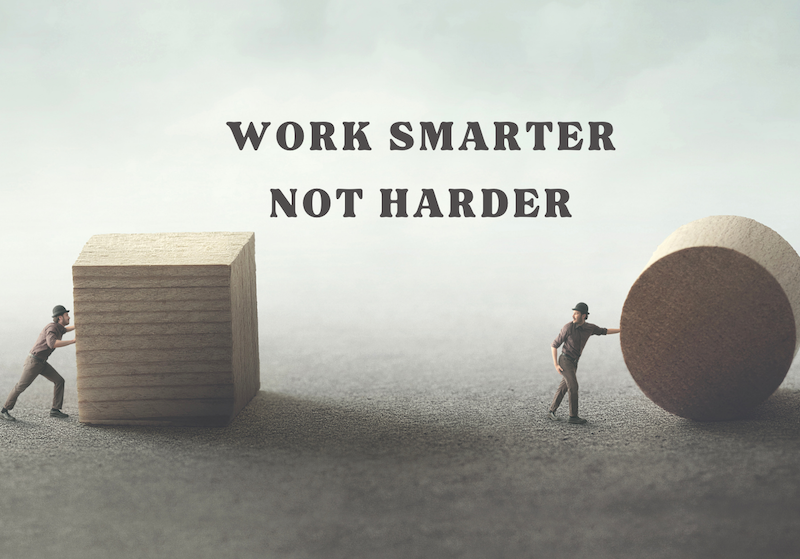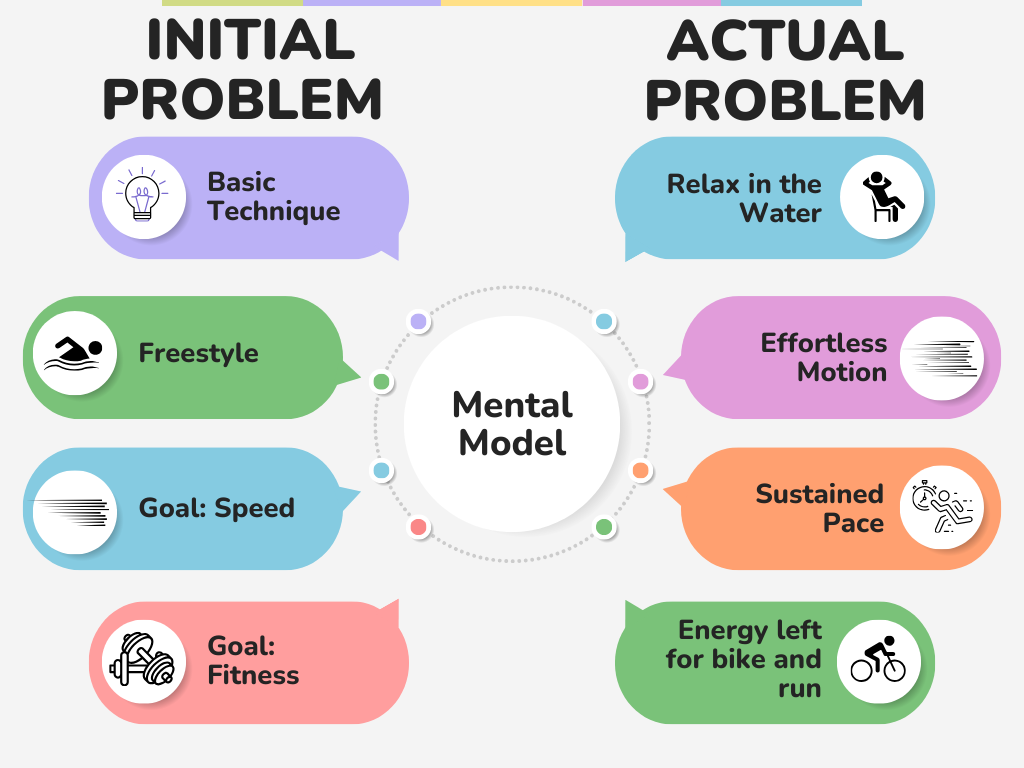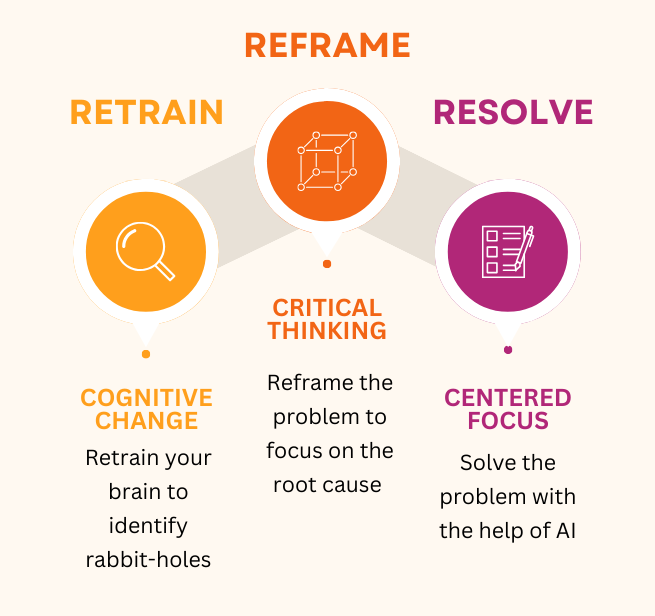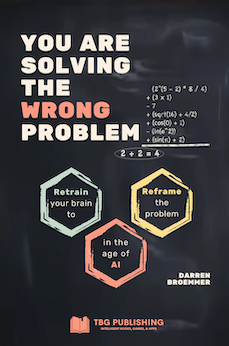From the book "You are Solving the Wrong Problem"Chapter 1: Introduction
"To ask the right question is already half the solution of a problem." - Carl Gustav Jung, Swiss psychiatrist and founder of analytical psychology.
The world urges us to move fast and think on our feet. This approach may work for easy problems, but it often leads us to spin our wheels when facing tough ones. We may think we're on the fast track, but we end up getting sidetracked and going down rabbit holes. As a result, solutions are no closer than when we started.
If you find yourself in this situation, you are not alone. The rapid pace of modern life has trained us to think fast, but we often feel lost when tackling substantial problems. It's easy to become frustrated and throw in the towel.
What if, instead of giving in to the frustration, you took a step back and examined problems for what they are? What if different perspectives transform each problem into opportunities to discover your untapped strength.
Embark on a transformative journey with me as we dive into the essence of problem-solving, leveraging the lessons learned during my career as a consultant, entrepreneur and Big Tech engineer. Throughout my professional endeavors, I've dedicated myself to crafting simple, effective solutions for customers. It was only midway through this journey that I realized a significant portion of my effort was wasted.

I abandoned swim lessons when I was a child. During the first class, the teacher threw some pennies in the water. As they sank to the bottom of pool, he instructed us to go get them. Immediately, I knew that was the end of lessons for me. My deep-rooted fear of the water prevented me from submersing myself to look for them. This fear continued to impact my life well into adulthood. It had the most profound impact in my role as a parent. While my daughter enjoyed swimming and eagerly explored the deep end of the pool, my fear prevented me from fully engaging in these activities. Family vacations at the beach were even worse. The vast expanse of open water was particularly terrifying.
It became clear that a comfort level in the water was a personal requirement. As a secondary motivation, it was also essential for me to pursue my goal of competing in triathlons. As someone who had always been a devoted runner and had developed decent cycling skills over time, triathlons had become a personal ambition. However, I recognized that every triathlon began with a swim, and I needed to conquer that challenge in order to have a chance at completing the race.
I needed to learn to swim, and I wanted to swim fast.
My initial approach to training for swimming was based on my existing knowledge and experience. When it came to running and cycling, the concept was straightforward: the more you practice, the better you get. Improvement was primarily driven by putting in the miles. The technical aspects didn't require a stringent focus to see progress. However, I soon realized that swimming operates under a different set of principles.
The Problem Plateau
Lets backup in the story first. I started with individual swim lessons. This provided a comfortable environment to get started. Since there was only one person with me, I wasn't embarrassed by my inability. Fortunately, my basic fear had diminished over time. However, my main concern was sinking. If my feet weren't firmly planted on the pool floor, I found myself going under the water.
I later joined an adult swim class. At that point, it was good to be with like-minded individuals. I was able to propel myself in the water, although at a slow rate. However, I found myself quickly exhausted after swimming a short distance. Despite being in decent shape for someone in their late 30s or early 40s, I couldn't help but notice others effortlessly swimming lap after lap. Why was I constantly out of breath?
I felt stuck, like I had reached a plateau. Progress had been made, but the underlying problem was not solved. I didn't feel at ease in the water, and I knew I couldn't successfully complete the swim portion of a triathlon. At best, I could exit the water completely drained, with little energy left to complete the race.
The problem was, I was solving the wrong problem
This is where the genesis of our approach began - the realization that I needed to adopt a different perspective and retrain my brain to address the issue. It became apparent that continuing with the same ineffective approach was only leading me down a fruitless path.
To rectify this, I took a step back and delved deeper into my research. I enrolled in swimming lessons and engaged in extensive conversations with coaches. I voraciously consumed any literature related to swimming that I could get my hands on.
During my exploration, one swim school captivated my attention above all others: the Total Immersion program developed by Terry Laughlin. Determined to learn from this approach, I committed myself to attend a swim clinic in Philadelphia, despite the distance. To make it there, I woke up at 3 AM one Saturday. It was during that clinic that everything finally clicked.
Swimming laps was now a rather natural feat for me. While I may not have been the fastest swimmer in the pool, I could consistently maintain a sustained pace. I had finally achieved a sense of comfort in the water. It was as if a figurative light bulb illuminated above my head. Water could be my ally rather than my adversary.
So, what brought about this revelatory "Aha" moment? It boiled down to the fundamental principle of Total Immersion swimming: striving to be as effortless as possible in the water.
I didn't need the learn-to-swim-school. I certainly didn't need the learn-to-swim-fast school. I needed the learn-to-swim-completely-relaxed-with-minimal-effort school.
A DARPA study showed that humans only convert 3% of expended energy into forward motion while swimming. Compare that to dolphins which convert an astronomical 80% of their energy into forward motion in the water.
I realized I was approaching the problem all wrong, leading to the creation of the second pillar of our approach. It became necessary for me to reframe the problem I was attempting to solve.

Through practicing relaxation, I discovered I could enhance my overall efficiency. Counterintuitively, I found that slowing down actually allowed me to achieve greater speed. By carefully analyzing the hurdles I encountered, I was able to redefine the problem at hand. In doing so, I pinpointed the core issue. For me personally, this was the need to minimize effort. This realization did not immediately present itself at the initial stages of the process.
The solution was not a quick fix. It was, however, a simple solution.
When I was tense in the water, most of my effort was going to waste. However, upon learning to relax, I discovered that the buoyancy of the water naturally lifted me up. This enabled me to shift my focus towards propelling myself forward. In contrast, when my body remained tense, it would sink. As a result, I found myself expending energy swimming against the water's resistance rather than making progress forward. It is no wonder that I felt exhausted.
Who should read this book
After years of experience as a consultant and engineer in Big Tech, I discovered techniques that can be powerfully applied to technology, business, and everyday life. This book shares those techniques to help you approach challenges in new ways. You will see how shifting your perspective enables you to discern what truly matters.
Technology can be as much of a distraction as it is an aide. You will learn how to leverage Artificial Intelligence (AI) to accelerate your problem-solving. When you combine a human-AI collaboration with a focus on the real problem, you will find that problem-solving is your new superpower. Here are just a few problem areas in which this book can help you.
- Mental health issues such as anxiety or depression: I have had massive struggles with these issues in my own life, and many of the fundamental principles in this book are based on overcoming them.
- Finding business opportunities in untapped markets: Entrepreneurs or business leaders can invert the problem and work backwards from the customer to find compelling value propositions and product-market fit.
- Engineering challenges: You may be learning to code or struggling with difficult software algorithms. I show you how to simplify complex processes and break them down systematically.
- Fear of public speaking: This is a common fear, and you want to overcome it to reach the next level. The techniques can help you identify the root cause and reframe your negative thoughts. You can use mindfulness to ease your worries and build confidence through preparation.
- I don't have enough time in the day: Prioritization is a huge problem in and of itself. If you feel overwhelmed by a heavy workload, you can use the framework here to set achievable priorities, become more efficient, and take purposeful breaks to boost energy.
- How to engage students in a classroom: Struggling to hold students attention? Learn how to use AI to come up with dynamic lesson plans.
- Not sure what to do with my life: If you feel stuck in life without direction, use the techniques here to create your roadmap through self-reflection on your core values.
- Ethical dilemmas in your personal or professional life: The holistic framework here can guide you to determine what is truly important so that you can deal with it appropriately.
- Interpersonal relationships may be a roadblock. If you want to resolve disagreements, you can improve communication through active listening, seek common ground by focusing on shared goals, and rebuild trust patiently over time using the approach in this book.
- Lack of innovation: You or your company can spark creative thinking by questioning assumptions, allowing time for open-ended idea generation, and prototyping early.
Even if your specific issue is not listed here, the framework serves as an adaptable toolbox you can customize to overcome your specific personal, professional or technical roadblock.
It really is amazing how simple shifts in thinking can reshape how you solve problems. You will be filled with a renewed purpose and equipped to navigate the challenges ahead of work and life.
The three pillared approach

Earlier in my life, I struggled with anxiety, which led me to participate in cognitive behavioral therapy. It was during this time that I learned the first pillar: Retrain your brain. I discovered how to recognize harmful thought patterns and redirect my focus to the present reality. This allowed me to break free from fictional problems and concentrate on the actual challenges I faced. It was truly life-changing.
After mastering this technique, I realized it could also help me solve engineering problems. For this purpose, I needed to retrain my brain to prevent myself from going down irrelevant paths. These mental pathways weren't about anxiety; they related to solving the wrong problem. I began questioning the problems themselves. What is it I'm actually trying to achieve? What is the real problem I need to solve? This realization became the second pillar of the approach: Reframe the problem.
You'll be amazed at how simple everything is after you reframe the problem. When you veer off in the wrong direction, complexity is bound to follow. If we aren't addressing the root cause, we are wasting our time. Reframing the problem is the first step on the journey to finding the actual solution. It offers three key benefits:
- It forces you to contemplate the root cause, which is the core of what you're aiming to solve.
- It reinforces the importance of the "retrain" step and reorients your thinking in the right direction.
- It allows you to redefine the problem in a way that is advantageous to your objectives.
The final pillar is Resolve the problem. I possess the innate capability to immerse myself in a task, channeling my focus with an intensity that allows me to disregard external distractions. While this proficiency enables me to dive deep into endeavors, it occasionally proves to be a double-edged sword, as what may be a great strength can also manifest as a potential weakness. Once I start down an errant path, it's easy to merrily continue on my way. This is exactly what we want to avoid. Life is too short to waste time. However, once you've leveraged the first two pillars and are focused on the right problem, maintaining a laser focus is essential. At that point, you want to channel all your energy into solving the actual problem.
So what does reframing a problem look like?
How an average athlete became the best
In the mid-1960s, a high jumper named Dick Fosbury was struggling to be successful. As a high-school sophomore, he was unable to complete a five-foot jump. This was the basic qualifying height for most high school track meets at the time.
The conventional technique used by athletes in the event was the straddle method. This technique required a complex series of movements where the jumper individually lifted their legs over the high jump bar. They were face down while crossing over the bar.
Frustrated by a lack of progress, Fosbury decided to forge his own path. Instead of conforming to the conventional technique, he envisioned a radical approach. Over time, he altered his jumping technique so that as a senior, he was clearing the bar in a backward manner. He led with his head and curved his body over the bar while kicking his legs up at the end to ensure clearance. His high school coaches encouraged him to return to the conventional technique. Eventually, they relented once they saw what he could do.
The rules of the sport require jumpers to leap off of one foot. There is no restriction on how to pass over the bar. Fosbury's technique required him to land on his back. Fortunately, before his junior year, the landing pit at his high school changed. It transitioned from wood chips to a softer material. This allowed him to land safely.
Using his newly developed technique, Fosbury ascended to greatness. At the Mexico City Olympics in 1968, he astonished spectators and won the gold medal. His success was a testament to reframing the problem. He became an instant icon in the world of athletics. The technique is now called The Fosbury Flop. It secured him an Olympic victory and transformed the sport in the process. High jumpers worldwide adopted the Fosbury Flop. What began as a personal quest for improvement turned into a lasting legacy.
Just like Fosbury, you can work backward (pun intended) to identify the root cause of your problems. By reframing and focusing on the real issues, you can boost your productivity. You can train yourself to think critically and become a better problem solver. The brain may not be a muscle per se, but it can be exercised and trained like one.
AI accelerated problem-solving
AI is revolutionizing problem-solving methodologies. AI assistants like ChatGPT and Claude AI can collaborate with humans, offering indispensable insights and recommendations. The combination of human critical thinking and AI is incredibly powerful. Prepare to be astonished by what you can achieve.
AI provides a fundamental and innovative tool for problem-solving. It is used throughout the three pillars of our approach. It can help identify root causes and validate assumptions. You can utilize it to rapidly analyze vast datasets, even without advanced data science skills. An AI assistant can process customer feedback and uncover underlying pain points that humans may have overlooked. It can aid in testing hypotheses and predicting outcomes.
To be clear, AI does not replace human intuition; rather, it enhances our problem-solving capabilities. AI serves as an indefatigable brainstorming companion, leveraging immense computational power to complement human judgment and oversight. It can help explore a wide range of possibilities, generate alternative solutions, and aid in their evaluation.
AI can assist in reframing and resolving problems, but it still requires you to retrain your brain. We will dive deep into how you can accomplish this. AI assistants can expedite the remainder of the process. They can suggest new perspectives that you may not have considered previously. By combining our strengths, we can solve problems that neither humans nor AI could tackle alone.
The future of problem-solving lies in human-AI collaboration. Together, we can become more intelligent problem solvers and develop innovative solutions. It all begins with a simple question, something that many people fail to recognize.
You first have to determine the right question to ask.
AI possesses significant potential, but it is not fully autonomous – not yet, at least. Its functionality begins with a prompt. In the emerging field of Prompt Engineering, experts focus on determining the most effective methods of formulating questions for AI. However, this technology is still new and not completely understood, even by its creators. You may have come across advertisements for expert sets of 1,000 ChatGPT prompts, claiming that "you're using ChatGPT incorrectly", and you are missing out on these "special" prompts. In reality, there is nothing inherently special about these prompts. They are just a compilation of ideas packaged in the form of questions. Without a specific goal in mind, they can serve as a guide for brainstorming. However, I don't know that they will solve a specific problem you have. Pre-packaged prompt lists are what they are.
To leverage AI effectively, you must have a clear understanding of the problem you are trying to solve. The prompts that you truly need should arise from identifying what you are trying to accomplish.
So how can we know exactly what it is we are trying to accomplish? The first step on the journey is to exit our normal autopilot mode.
Chapters
2. Step out of Auto-Pilot Mode
3. Your most important skill: Asking Questions
4. Solve any problem using the Five Whys
5. AI Prompting like a Pro
6. Invention over Convention
7. How to Reframe a Problem to your Advantage
8. The Diamond Pattern: First fan-out, then fan-in
9. The Problem Paradox
10. Break free from Cognitive Bias
11. From Complex to Simple
13. Use AI for Data Analysis
14. The Curiosity Rule
15. Improve productivity by eliminating distractions
16. Optimization Problems
17. Greenfield or work within current constraints
18. Managing the most scarce resource: Time
19. Challenge yourself with Puzzles
20. Next Steps
21. Solutions to Puzzles

